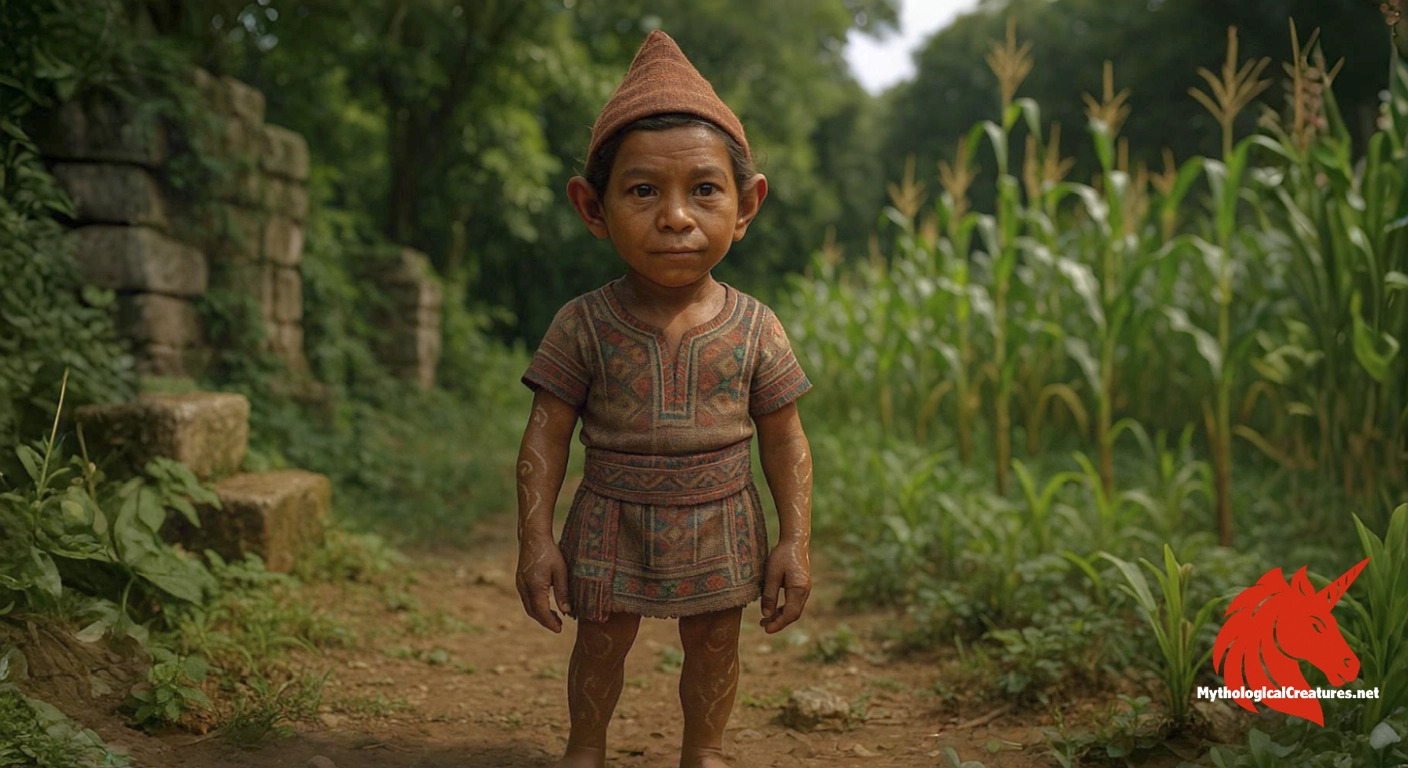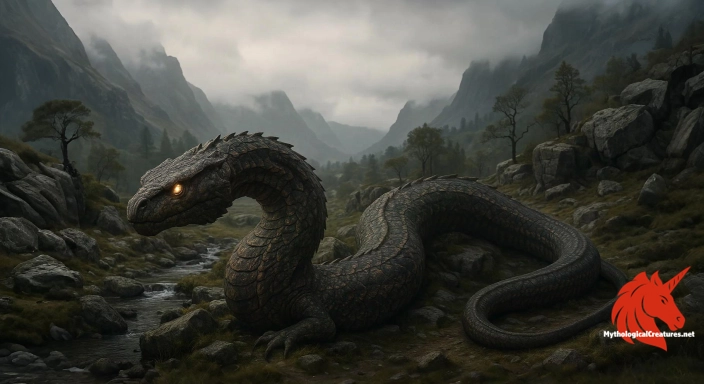Alux: Aluxo'ob are small, sprite-like spirits from Maya mythology known for their dual nature of mischief and protection.

Alux
Alux - Aluxo'ob are integral to traditional Maya spiritual practices, aiding in agriculture by summoning rain and protecting crops, while also serving as mischievous enforcers when not properly respected.
Origins & First Encounters
Alux are intriguing small spirits deeply rooted in Maya mythology and revered as mystical sprites. They are believed to inhabit the natural landscapes of the Yucatán Peninsula, Belize and Guatemala, forming an integral part of the region's cultural heritage. These entities are closely associated with agricultural rites, where their presence is thought to ensure a bountiful maize harvest and protect the land. Local traditions often portray them as both benevolent guardians and mischievous tricksters, capable of helping or hindering depending on how they are treated. Many accounts suggest that alux may be the very souls of ancestral beings or a manifestation of the land’s enduring spirit, predating any Western influence. Oral traditions, passed down through generations, have kept alive the legacy of these sprites, even though they remain largely invisible to the untrained eye. Their elusive nature adds an air of mystery and encourages respectful offerings and rituals among local communities. Over time, the characterisation of the alux has evolved, blending ancient customs with the varied influences that have shaped the region’s history. Their dual role as both protector and prankster lends depth to the multifaceted relationship between the people and the natural environment. The enduring allure of the alux continues to inspire reverence and curiosity, sustaining their presence in regional folklore.
Source Texts & Tale Variants
Stories concerning the alux have been sustained through a rich variety of oral and written traditions over the centuries. Early Maya narratives, although not always documented in text, alluded to small, nature-bound spirits whose actions influenced the fortunes of local communities. Diverse folklore accounts describe encounters with these sprites in intimate detail, often revolving around agricultural cycles and the sanctity of the land. Some traditions recount that a small house built on a farm could call the alux into being, a practice that has led to multiple local variants of the tale. Additionally, Nahuatl-speaking communities refer to similar entities as Chanekeh or Chaneque, further diversifying the narrative. Spanish colonial records have occasionally used the term duende, thereby linking the alux with broader Hispanic supernatural traditions. Variations of the myth often differ in the specifics of the interactions, such as the necessity of offerings or the consequences of neglect. A number of post-colonial retellings have enriched the original lore, integrating elements of both indigenous beliefs and European fairy-tale motifs. Contemporary accounts continue to adapt the legend, ensuring that the alux remains a dynamic element of Mesoamerican folklore.
Form & Powers
The alux are typically depicted as diminutive figures, only about knee-high, embodying the appearance of traditionally dressed Maya individuals. Their facial features tend to be sharp and alert, revealing an almost otherworldly expression despite their small size. Often, they are portrayed wearing intricately embroidered garments that echo the traditional attire of rural Maya communities. Their clothing and accessories are sometimes imbued with subtle symbolic motifs drawn from nature and ancestral iconography. While generally considered invisible, these sprites are said to materialise at will, revealing a more tangible, albeit fleeting, form. This duality between visibility and invisibility adds to their mystique and reinforces the idea of them as liminal beings. Artists and storytellers have sometimes embellished their appearance with hints of ethereal light or a mischievous glint in their eyes. The physical portrayal of alux often highlights their slender yet agile build, suggesting a capacity for swift movement and clever antics. Descriptions consistently emphasise their intimate connection with the natural environment, as seen in the earthy tones and patterns of their attire. Overall, the detailed imagery of the alux serves to encapsulate both their enigmatic nature and their significant cultural presence.
Regional Faces
Across Mesoamerica, the portrayal of the alux varies subtly to reflect the distinctive cultural contexts of each region. In the Yucatán Peninsula, these sprites are most commonly linked with maize fields and the everyday life of rural farmers, where they are believed to actively influence agricultural success. In Belize and regions of Guatemala, local interpretations often merge the alux with other indigenous spiritual guardians, resulting in a synthesis that highlights protective attributes over natural landmarks. Nahuatl-speaking communities, meanwhile, introduce additional layers to the myth by referring to similar creatures as Chanekeh or Chaneque. In some areas, the alux are further associated with specific natural formations such as caves, forests, or notable stone structures, indicating a broader territorial spirit. Regional festivities and local rituals sometimes include the construction of small shrines specifically dedicated to these beings, a practice that varies from one community to another. Local artistic renditions are also infused with regional colour and symbolism, lending each depiction a unique flavour. These local adaptations underscore the flexibility of the alux myth, reflecting the diverse environmental and cultural settings in which the legend survives. Despite such variations, a common belief in their role as both protectors and playful mischief-makers unites these regional traditions.
Cultural Parallels
The narrative of the alux resonates with similar mythological figures from a variety of cultural traditions around the world. Parallels can be drawn between the alux and the Irish leprechaun, both of which are characterised by their small stature and propensity for mischief. Like the Scottish Brownie, these sprites are depicted as both helpful household guardians and unpredictable tricksters, bestowing luck or causing minor calamities in equal measure. They share a universal archetype with other diminutive supernatural beings who protect the land or reward rites and respect through subtle interventions. The Spanish duende, often used interchangeably in some accounts, further illustrates the cultural interplay that enriches the alux myth. In Scandinavian folklore, figures such as the tomte echo similar sentiments, symbolising a guardian spirit imbued with both benevolent and capricious qualities. Such cross-cultural comparisons highlight a recurring theme in global mythology: the existence of small, elusive entities that bridge the gap between the human and natural worlds. Each portrayal, although adapted to its specific cultural context, underscores the enduring human fascination with the unseen forces that influence daily life. This comparative lens reveals that the alux, while uniquely embedded in Maya tradition, is also part of a broader tapestry of folklore that celebrates nature’s mysteries.
Legacy & Modern Evolution
The evolution of the alux reflects a dynamic narrative that has transitioned from ancient oral traditions to a recognised element of modern cultural identity. Early depictions placed these sprites firmly within the domain of agricultural rituals and ancestral honour, where they were revered as both protectors and playful tricksters. As cultural interactions expanded during the colonial and post-colonial eras, the image of the alux absorbed new influences without losing its essential link to the land. In contemporary times, small shrines and dedicated spaces on farmland continue to symbolise the presence of alux, reinforcing local customs and communal respect. Their portrayal has been further revitalised by modern media, with recent anecdotes even capturing public attention through social media and official endorsements. Each new retelling adds layers to the traditional narrative, blending historical superstition with a modern appreciation for indigenous folklore. Today, the alux serves not only as a symbol of the mysterious forces of nature but also as a bridge connecting past, present and the evolving cultural landscape. The enduring fascination with these sprites reflects a broader resurgence of interest in indigenous mythologies and their relevance to contemporary life. Their legacy is a testament to a resilient cultural spirit, ever adaptable and deeply intertwined with the natural world. Through modern reinterpretations and academic interest alike, the alux continues to occupy a unique and cherished place in the heart of Maya heritage.
Interesting Fact
In 2023, a purported sighting of an alux by an engineer, later shared by President Andrés Manuel López Obrador, renewed widespread public curiosity about these elusive spirits.
Quick Creature Info
Origin:
Features:
Associations:
Our Mythic Legendary Rating:

Also Sometimes Known As:
Habitat:
Supernatural Powers:
Physical Attributes:
Abilities:
Behavior:
Weaknesses:
Lore:
Related Creatures, Tales or Lore
References
Discover Another Mythical Legend You May Not Have Heard Of?
Uncover the mysteries of ancient folklore and expand your knowledge of legendary beings from cultures around the world.
Dare to Meet the Fáfnir....
Curated by the Mythological Creatures Team (rev. May 2025)
